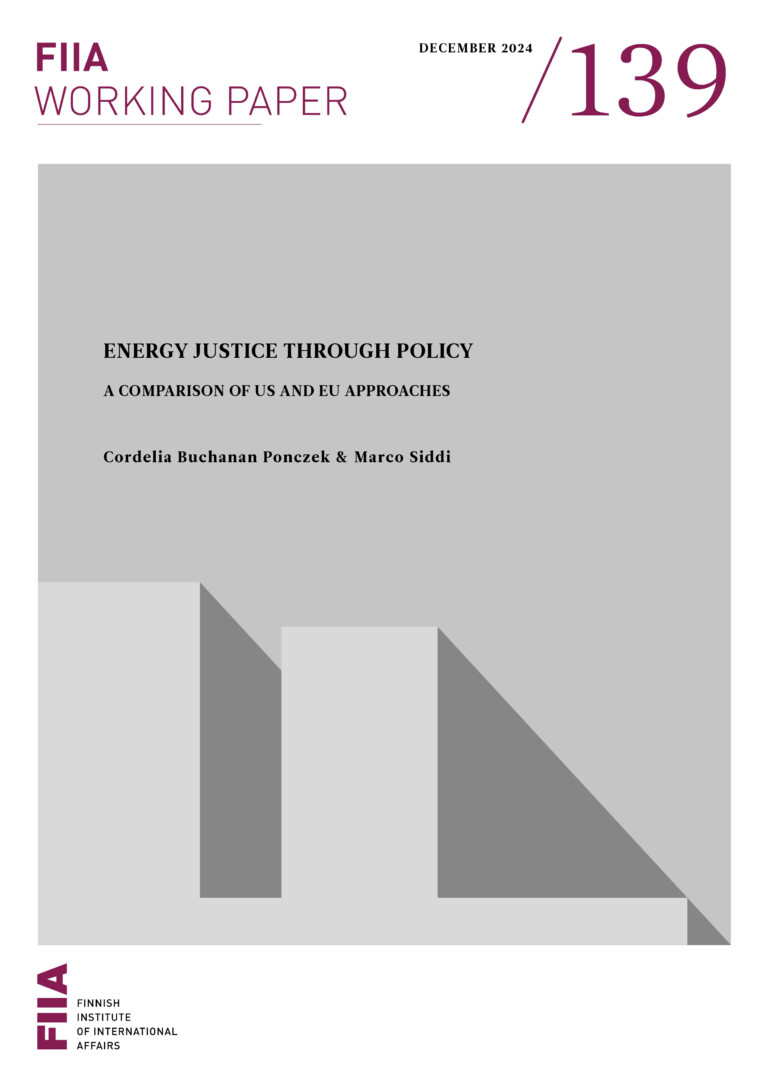Finland and Norway are planning to build the Arctic Railway, stretching from Rovaniemi to Kirkenes through the homeland of the indigenous Sámi people.
The state governments have acknowledged their duty to consult with the Sámi, whose culture and livelihoods the railway would affect, but the Sámi have dismissed the consultation efforts thus far as inadequate and have denounced the project.
The dispute has exposed the ambiguity of the state’s duty to consult with indigenous peoples: international law firmly establishes the duty but does not prescribe specific rules for carrying it out.
In Norway, the domestic regulatory framework concerning the consultation duty is more evolved and the practice of implementation is more consistent than in Finland, but both states still lack an effective legal incorporation of the duty.
Despite the ambiguity, the scope of the consultation duty is determined by its purpose: creating favourable conditions to reduce power disparity between the state and indigenous peoples in order to reach an agreement that reconciles national interests with indigenous rights.
Introduction
In her recent statement to the UN Human Rights Council, Special Rapporteur on the Rights of Indigenous Peoples Victoria Tauli-Corpuz drew attention to a common global pattern of large-scale projects bypassing the fundamental right of indigenous peoples to be consulted and to give or withhold their free, prior and informed consent (FPIC).1 While the validity of the state’s obligation to consult with indigenous peoples before adopting any measures that might affect them is indisputable, the content and scope of this duty are imprecise. This creates an opportunity for state governments to pursue national strategic interests at the expense of indigenous rights – whether knowingly or negligently.
The prospective Finnish-Norwegian Arctic Railway project has highlighted the issue of disagreement as to what the consultation duty entails and how much engagement of the indigenous people it requires. This Briefing Paper reviews the dispute, discusses international and domestic Finnish and Norwegian legislation framing the consultation duty, and outlines the existing approaches to it. The paper argues that the lack of a uniform legal framework poses challenges to the development of such projects as the Arctic Railway and the relations between the states and indigenous peoples, but it should not necessarily prevent the states from the diligent performance of the duty. Ultimately, the scope of the consultation duty is determined by its purpose: reducing power disparity between the state and indigenous peoples in order to reach an agreement that safeguards indigenous rights and reconciles them with competing national interests.
The Arctic Railway controversy
Finland’s attempts to establish a transport corridor to the Arctic harbours date back to as early as the 1920s. The Arctic region’s growing economic potential prompted the Finnish government to revive the initiative and give it particular attention while the state holds the chairship of the Arctic Council. In March 2018, the Finnish Transport Agency in collaboration with the Norwegian Railway Directorate published the Arctic Ocean Railway Report.2 The purpose of this report was to assess the technical feasibility and potential economic and environmental impacts of five alternative rail routes, which would connect Lapland with the Arctic Ocean. Following the evaluation, the Finnish and Norwegian authorities decided to move forward with the Rovaniemi–Kirkenes railway link and tasked a joint working group with examining it further. The deadline for the working group’s follow-up report expired on December 14 and the publication of the report has been delayed.
A railway connection extending to the shores of the Barents Sea could enable access to global trade routes, thereby likely transforming Finland’s logistical position to a Northern European junction of freight and passenger traffic. The project’s economic success would largely depend on the amount of cargo flow. It is a crucial factor for potential investors but one that is difficult to measure at this point, as it hinges upon the prospects of other developments in the region, primarily the viability of the Northern Sea Route. According to Finnish Transport Minister Anne Berner, the railway would also improve Finland’s security of supply, but the National Emergency Supply Agency did not share this view, citing the risks associated with the railway’s proximity to the Russian border.
Economic considerations and uncertainties are not the only challenges to the project’s planning and implementation. The Rovaniemi–Kirkenes connection would run through the homelands of the indigenous Sámi people and is expected to inflict damage on the environment, reindeer husbandry and the traditional lifestyle of the Sámi. In fact, the Arctic Ocean Railway Report has acknowledged that the Rovaniemi–Kirkenes route would be more environmentally disruptive than the other four considered Arctic rail route options but selected this route based on the anticipated economic impact and investment costs.
In early September 2018, local Sámi associations, supported by Greenpeace, participated in a series of protests in the Finnish Sámi region. Shortly afterwards, the Finnish Sámi parliament’s president, Tiina Sanila-Aikio, opened the Arctic Parliamentary Conference with a speech in which she described the planned railway project as a manifestation of the Arctic ‘gold rush’. Sanila-Aikio warned listeners about the project’s potential implications for the Sámi people, especially for reindeer herders and fishers. Significantly, she emphasised the state’s duty to consult with the Sámi and seek their consent – a principle embedded in the right to self-determination and firmly established in international law.3
The Saami Council, which represents the Sámi people across the borders of Norway, Sweden, Finland and Russia, issued a statement to reiterate their position on the Arctic Railway. It denounced the planned project as an encroachment on traditional Sámi lands with harmful consequences for the indigenous culture, language and nature-based industries. The Saami Council demanded that the Finnish and Norwegian governments carry out an assessment of the Arctic Railway’s economic, ecological, social and cultural impact on the Sámi people. It also underlined that state officials must consult with Sámi representatives throughout the process in order to acquire their FPIC.4
The Arctic Ocean Railway Report claims that the Finnish and Norwegian authorities have involved Sámi representatives in the Arctic Railway planning and pledged to ensure their participation in the future stages of the project.5 The Finnish Transport Ministry specified that the state authorities would issue guidelines on the interaction with the Sámi parliament as the project progresses.6 However, the Saami Council’s statement declares that the governments have failed thus far to respect Sámi rights and accommodate their concerns. Furthermore, according to the recent statements by the Finnish Sámi Parliament’s representatives, the working group responsible for the preparation of the follow-up report has still not taken the views of the Sámi delegations into account.7 Fundamentally, this disagreement between the states and the Sámi people stems from the uncertainty about the required level of the indigenous peoples’ engagement in the relevant national decision-making processes.
The consultation duty in international law and practice
The duty of states to consult with indigenous peoples before making any decisions that might affect them is the foundational principle of the protection of indigenous peoples. The principle is enshrined in the Indigenous and Tribal Peoples Convention (ILO 169 Convention) and the UN Declaration on the Rights of Indigenous Peoples (UNDRIP). Over 160 states, including Finland, have not ratified the ILO 169 Convention. UNDRIP is the UN General Assembly’s resolution – a legally non-binding document (although some of its provisions arguably reflect customary international law).
Nonetheless, the state’s duty to consult with indigenous peoples is inherent in the right to self-determination and as such is firmly rooted in international human rights law. It derives from the universally accepted human rights treaties, such as the International Convention on the Elimination of All Forms of Racial Discrimination (CERD) and the International Covenant on Civil and Political Rights (ICCPR).
Even though the state’s duty to consult with indigenous peoples is widely recognised, its content and scope remain ambiguous. International legal norms spell out two main requirements concerning the consultation process: it must be carried out in good faith and with the objective of obtaining the consent of the indigenous peoples concerned.8 International law does not prescribe any further specific and universal legally binding rules for performing consultations with indigenous peoples. The ILO 169 Convention explains that states should apply measures aimed at the protection of indigenous rights in a flexible manner and determine their nature and scope based on the special characteristics of a particular country (Article 34).
Failing legal clarity, state governments continuously misconstrue what diligent performance of the consultation duty entails. State parties to the ILO 169 Convention are obliged to submit reports on its implementation at least every five years, in response to which they receive recommendations from the treaty’s supervisory bodies. However, as only 23 states have ratified the ILO 169 Convention so far, inadequate implementation of the state’s duty to consult with indigenous peoples remains one of the core issues encountered by indigenous communities across the world.
Former UN Special Rapporteur on the Rights of Indigenous Peoples James Anaya and legal scholar Sergio Puig have examined the relevant state practice and considered various interpretations informing the debate on the state’s consultation duty. The existing approaches vary from perceiving the duty as a regulatory burden and a value-neutral bureaucratic obstacle to viewing it as granting the right to indigenous peoples to withhold their consent and thereby hinder the state’s proposed measure. In Anaya and Puig’s opinion, consultation requires the meaningful and effective engagement of indigenous peoples in the relevant national decision-making processes, but it should not serve as a means of overriding state sovereignty and precluding state governments from acting legitimately in the public interest.9 Some states, notably Canada, have demonstrated a similar understanding of the consultation duty. Recent judgements by Canadian federal courts rejected both too narrow and too broad interpretations of the state’s consultation duty as deficient, and underlined that balance and compromise, rather than unilateral impositions from either of the parties, should guide the process of consultation.10
Anaya and Puig have proposed that the correct way to approach the consultation duty is to view it within the human rights framework from which it originates. Such an approach sees the key value of consultation in the government’s accountability and its capacity to protect indigenous human rights. Government authorities must take an active role in ensuring that consultations both comply with procedural standards (mitigation of power imbalance, transparency, appropriate timing, representativeness, etc.) and fulfil substantive requirements (impact mitigation, joint management arrangements, compensation, sharing benefits, etc.).11 States are thus obliged to create favourable conditions for achieving an agreement that prevents or compensates for any potential limitations or violations of indigenous human rights.
The consultation duty in Finnish and Norwegian law
Finland and Norway, the two states involved in the Arctic Railway project, derive the duty to consult with indigenous peoples from international law. Their domestic rules and practices differ, particularly in terms of the extensiveness of the duty’s regulatory frameworks and consistency of its implementation. However, both states still lack an appropriate legal incorporation of the duty.
Finland
Finland has not ratified the ILO 169 Convention, but its domestic Sámi Parliament Act establishes the state’s duty to negotiate with the Sámi Parliament on any significant measures that may directly affect the status of the Sámi as an indigenous people and relate to matters in their homeland (the law provides a list of such matters).12 It is noteworthy that the Act employs the word ‘negotiate’, which is wider in scope than ‘consult’ – the term used in the ILO 169 Convention. One major difference between the two notions is that negotiations take place prior to any decisions on proposed measures, whereas consultations place emphasis on providing information about decisions that are being or have already been made, thereby limiting the influence of indigenous peoples on the decision-making processes.13 However, despite using the term ‘negotiate’, the present formulation of the Sámi Parliament Act’s provision construes the obligation in narrow terms as an ‘opportunity to be heard and discuss matters’, which is more confined than the consultation duty enshrined in UNDRIP.
According to the Expert Mechanism on the Rights of Indigenous Peoples (EMRIP), a subsidiary body of the UN Human Rights Council, the discordance between the notion of negotiations and its restrictive definition in the Sámi Parliament Act not only creates conceptual inconsistency but is also incoherent with the UNDRIP requirements.14 EMRIP has acknowledged that the Finnish practice, notably as reflected in the Justice Ministry’s approved Memorandum and Guidelines for Negotiations, shows the state’s acceptance of these requirements, such as the duty to seek FPIC of the indigenous people. However, they are currently not legally binding.
The failure to adequately reflect the obligation of consultations or negotiations in law prevents the duty’s systematic and uniform implementation and impairs the Sámi people’s capacity to realise their corresponding indigenous right to effectively engage in the relevant decision-making processes. Therefore, EMRIP has advised expanding the present legal definition of the duty to negotiate envisioned in the Sámi Parliament Act. The amended definition should explicitly comprise specific elements, including the principle of good faith, the pursuit of FPIC, the guarantee of providing sufficient resources for the Sámi Parliament to participate in negotiations, the state’s duty to undertake prior impact assessments in cooperation with the Sámi, and the establishment of a mechanism to monitor the compliance of the agreements reached.
Regrettably, attempts to reform the Sámi Parliament Act have failed thus far. At the end of 2017, the Justice Ministry appointed a committee to prepare for the revision of the Act. However, in September 2018, the Sámi Parliament rejected the proposed draft amendments. One of the reasons for this was that, in the Sámi Parliament’s view, the government had not fulfilled its duty of conducting meaningful negotiations, rather than merely technical hearings, with the Sámi people during the process of the Act’s reform. Since the Sámi Parliament did not accept the draft reformed Act, it did not reach the legislators. Consequently, the legal definition of the duty to negotiate with the Sámi people as provided in the Finnish Sámi Parliament Act remains incongruous: despite the broad understanding of the duty implicit in the word ‘negotiate’, the Act explains it in a restrictive manner. It thereby increases the risk of adopting controversial decisions and compromising the relationship between the state and the Sámi people.
Norway
Norway was the first country to ratify the ILO 169 Convention in 1990. The ratification came right after a few other pivotal developments signifying the state’s redefined relationship with the Sámi people: the adoption of the Sámi Act, the constitutional amendment (current Article 108), which affirmed the state’s responsibility of creating favourable conditions for the Sámi to develop their language, culture and way of life, and the establishment of the Sámi Parliament. Thus, the ratification of the international treaty and the acceptance of its supervisory mechanism consistently followed the steps of recognising the Norwegian state’s commitment before its own nation and the international community to respect and protect the rights of its indigenous people.
In 2005, the Sámi Parliament and the Norwegian government signed the ‘Procedures for Consultations between State Authorities and the Saami Parliament’ (Consultation Procedures). This is the main framework agreement between the state and the Sámi, which details the implementation of the consultation duty when adopting legislative or administrative measures affecting Sámi rights and interests (additionally, the 2007 Consultation Agreement on Conservation specifies consultation procedures in matters concerning the designation and management of protected areas). The International Labour Organisation (ILO) has observed that the Consultation Procedures have helped to ensure policy coherence and the efficiency of mechanisms necessary for guaranteeing that state authorities act in a coordinated and systematic way when conducting consultations with the Sámi. According to the ILO, both the Sámi people and the Norwegian state have benefitted from the adoption of the agreement because it has facilitated the achievement of mutually acceptable solutions in the majority of cases.15
The Sámi Parliament has agreed that overall the Consultation Procedures have strengthened cooperation between the Sámi and the government. However, the implementation of the consultation duty remains challenging in some cases, particularly those related to energy development projects, reindeer husbandry and land use. One of the issues is that the Consultation Procedures define the objective of consultations as ‘achieving agreement’ rather than obtaining free, prior and informed consent (FPIC), which reduces the scope of the consultation duty and does not fully ensure the effective participation of the Sámi in decision-making.16 Furthermore, the Consultation Procedures do not constitute a national law but an agreement between the Sámi Parliament and the government. The UN Human Rights Committee urged Norway to adopt a law on consultations aimed at obtaining FPIC in order to guarantee a greater degree of implementation of the consultation duty.17
Hence, both the Finnish Sámi Parliament Act and the Norwegian Sámi Act lack an adequate incorporation of the state’s consultation duty, which would rigorously spell out the fundamental requirements that the duty entails, such as its goal of acquiring FPIC from the Sámi. Nonetheless, compared to Finland, in Norway, the regulation of the duty is generally more evolved and its practical implementation is more consistent. It owes much to the state’s legal commitment to the ILO 169 Convention and its consequent acceptance of the treaty’s supervisory mechanism, whose guidance and recommendations have been instrumental in steering domestic processes.
Conclusion
In accordance with the international and domestic legal requirements, both the Finnish and Norwegian authorities have recognised their obligation to engage the Sámi people in the planning of the Arctic Railway project. However, it is the extent of this engagement and the fact that it takes the form of a meaningful two-way dialogue that will determine whether the states fulfil their duty of consultation diligently. The Arctic Railway project, which would traverse the Finnish and Norwegian jurisdictions as well as the Sámi homelands, has exposed the issue of the absence of a uniform understanding of the state’s obligation to consult with indigenous peoples.
International law does not impose specific and universal rules for meeting this obligation. Finland and Norway have distinct domestic regulatory frameworks to accommodate the consultation duty. The Sámi people have thus far dismissed the efforts of the Finnish and Norwegian government authorities to consult them on the Arctic Railway project as inadequate. Such a lack of consensus poses a challenge to both the project’s development and the relationship between the Sámi people and the states under whose jurisdiction they live.
Nevertheless, it is also an opportunity for the actors involved to clarify the content and scope of the state’s duty of consultation by focusing on its purpose – reconciliation between national interests and indigenous rights. Fundamentally, the protection of indigenous rights does not oppose national interests but is rather one of them. However, the state-centric system of international law accords the state governments the right to choose among competing national interests. The consultation duty aims to limit this prerogative by reducing the power disparity between the state and indigenous peoples. In this way, it does not aim to negate state sovereignty, but rather to protect indigenous human rights from being subordinated to it.
Endnotes
1 Statement to the Human Rights Council 39th Session, 19 September 2018, https://www.ohchr.org/en/NewsEvents/Pages/DisplayNews.aspx?NewsID=23595&LangID=E, last accessed 6 December 2018.
2 Finnish Transport Agency, Arctic Ocean Railway Report, Helsinki, March 2018, https://julkaisut.liikennevirasto.fi/pdf8/lr_2018_arctic_ocean_railway_report_web.pdf, last accessed 9 November 2018.
3 Tiina Sanila-Aikio, Opening Speech at the 13th Arctic Parliamentary Conference, Inari, 17 September 2018, https://www.samediggi.fi/2018/09/17/opening-speech-by-president-sanila-aikio-at-the-arctic-parliamentary-conference-in-inari/?lang=en, last accessed 9 November 2018.
4 The Saami Council, Statement on the Arctic Railway, 23 September 2018, http://www.saamicouncil.net/en/article/statement-on-the-arctic-railway/, last accessed 9 November 2018.
5 Arctic Ocean Railway Report, pp. 5, 29; Norconsult, The Arctic Railway Report to the Norwegian Railway Directorate, pp. 6–8, https://julkaisut.liikennevirasto.fi/pdf8/norconsult_arcticrailway_web.pdf , last accessed 3 December 2018.
6 The Finnish Ministry of Transport and Communication, Press Release, 9 March 2018, https://www.lvm.fi/-/study-on-the-arctic-rail-line-completed-kirkenes-routing-to-be-examined-further-968073, accessed 4 December 2018.
7 Linnea Rasmus, Jäämeren radan jatkotoimia koskeva selvitys valmistumassa – Saamelaiskäräjät: "Saamelaisten näkemyksiä ei kirjattu raporttiin esittämällämme tavalla", Yle.fi, https://yle.fi/uutiset/3-10554107, last accessed 18 December 2018.
8 UNDRIP, Article 32(2), https://www.un.org/development/desa/indigenouspeoples/declaration-on-the-rights-of-indigenous-peoples.html, ILO 169, Article 6(2) https://www.ilo.org/dyn/normlex/en/f?p=NORMLEXPUB:12100:0::NO::P12100_ILO_CODE:C169, last accessed 3 December 2018.
9 Anaya, J., Puig, S., ‘Mitigating State Sovereignty: The Duty to Consult with Indigenous Peoples’, Arizona Legal Studies, Discussion Paper No. 16-42, 2018, pp. 11–21.
10 Supreme Court of Canada, Chippewas of the Thames First Nation v. Enbridge Pipelines Inc., 26 July 2017, Federal Court of Appeal, Tsleil-Waututh Nation v. Canada, 30 August 2018.
11 Anaya and Puig, pp. 17–30.
12 Act on the Saami Parliament, Section 9, https://www.finlex.fi/fi/laki/ajantasa/1995/19950974, last accessed 3 December 2018.
13 The UN Special Rapporteur James Anaya, Report to the UN Human Rights Council A/HRC/12/34, 15 July 2009, p. 16, para. 46, http://unsr.jamesanaya.org/annual-reports/report-to-the-human-rights-council-a-hrc-12-34-14-july-2009, last accessed 7 December 2018.
14 EMRIP, Country Engagement Mission in Finland: Advisory Note, 28 March 2018, paras. 16–29, https://www.ohchr.org/Documents/Issues/IPeoples/EMRIP/Session11/AdvisorynoteFinlandFinaltoParties.docx, last accessed 7 December 2018.
15 ILO, Procedures for Consultations with Indigenous Peoples: Experiences from Norway, Geneva, 10 November 2016, pp. 36–38, https://www.ilo.org/global/topics/indigenous-tribal/publications/WCMS_534668/lang--en/index.htm, accessed 7 December 2018.
16 The Sámi Parliament, Report to the Human Rights Committee, 5 February 2018, pp. 13–16, https://tbinternet.ohchr.org/Treaties/CCPR/Shared%20Documents/NOR/INT_CCPR_CSS_NOR_30246_E.pdf, last accessed 7 December 2018; The Sámi Parliament, ILO Report 2018, pp. 14–16.
17 Human Rights Committee, Concluding Observations on the Seventh Periodic Report of Norway, CCPR/C/NOR/CO/7, 25 April 2018, p. 6, https://tbinternet.ohchr.org/_layouts/treatybodyexternal/Download.aspx?symbolno=CCPR%2fC%2fNOR%2fCO%2f7&Lang=en, last accessed 7 December 2018.








